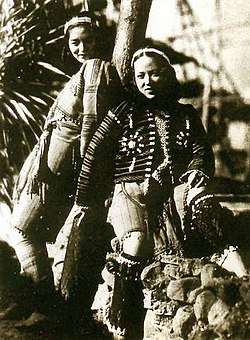Manchukuo Film Association
Manchukuo Film Association Ltd. (満洲映画協会, Manshu Eiga Kyokai, or 満映 (Man'ei)) (Chinese: 株式會社滿洲映畫協會), also known as the "Manchuria Film Production", was a Japanese film production company in Manchukuo in the 1930s and 1940s.

Early history
The Manchukuo Film Association was established on August 14, 1937, as a national policy company (国策会社) a fifty-fifty joint venture between the government of Manchukuo and the South Manchurian Railway Company. The original studios were located at a former woollen goods factory, with the offices at the former Jilin Architectural Institute (吉林省建築設計院) in Jilin Province. Unlike Japan's overtly "colonial" film markets in Taiwan and Korea, the Manchukuo Film Association was from the first promoted by the Japanese as being a Japanese-run Chinese film studio. Man'ei grew out of the Southern Manchurian Railway's Photographic Division which was initially charged with producing industrial and educational films about Manchukuo to educate Japanese audiences. Negishi Kan'ichi was recruited from his post as Head of Nikkatu's Tamagawa Studios to come to Man'ei to rationalize feature film production there. Promotional materials from the Studios boasted that Man'ei had the most state-of-the art facilities in all of Asia at that time.[1]
Nobusuke Kishi, one of the top officials involved in the industrial development of Manchukuo, enlisted Masahiko Amakasu, head of Manchukuo's Ministry of Civil Affairs, to manage the operation in 1939 replacing Negishi. Amakasu threw himself wholeheartedly into his appointment effectively using his status as a film industry outsider as well as his notoriety as the murderer of Osugi Sakae and family to maintain Man'ei's independence from the Japanese film industry. Amakasu was frequently critical and sometimes hostile to Japanese criticism of Man'ei. As a result of a 1936 tour of Nazi Germany and Fascist Italy, Amakasu was able to see the great European studios of Germany's Universum Film AG and Italy's Cinecittà first hand. After taking up his post at Man'ei Amakasu was determined to rationalize the studio's production system after UFA to compete with both Hollywood and the Japanese film industry.[2] This included using agents of the Towa Company to assist him in procuring the latest German movie cameras and production techniques. Amakasu also hosted notables from the Japanese film industry including movie stars, directors, and conductors (such as Takashi Asahina). Perhaps what was most unique about Amakasu's Man'ei was its staff. Although Amakasu was considered Right-wing, he was unusually broadminded in hiring many left-wing and Communist sympathizers at a time when they were being purged from the Japanese film industry. In this sense, Man'ei resembled Hollywood, UFA, Cinecittà, and Shanghai as a cosmopolitan film center bringing together film personnel from a variety of ethnicities and political persuasions.
Amakasu is also credited with launching the career of the actress and singer Yoshiko Ōtaka, better known as "Ri Kōran".[3] But more importantly, Man'ei under Amakasu was unique for its insistence on self-sufficiency. Breaking with other Japanese colonial film markets, Amakasu maintained that his primary audience was in fact not the Japanese, but rather the Manchurians. In a 1942 article entitled, "Making Films for the Manchurians," Amakasu stated; "There is absolutely no need to make films that exoticize Manchukuo for Japan. Japan will probably make their own films that get it wrong anyhow, vulgarizing the unusual aspects of Manchuria. We must not forget that our focus is the Manchurians and, after we make headway, nothing should keep us from producing films for Japan."[4]
Man'ei produced a large number of films, falling roughly into three categories: "human drama", "educational" and "documentary". The Japanese government continued to provide financial support, and the Association produced works which spoke as positively about the Manchukuo government as possible.
Separation
In 1945, following the Soviet invasion of Manchukuo and subsequent chaos surrounding the surrender of Japan, the studio disintegrated. The Soviet Red Army looted its equipment and Masahiko Amakasu committed suicide by taking poison. In August 1945 the Communist Party of China and the Kuomintang fought over the rights to the former company. By April 1946 the Communist Party of China officially took control of the Association and merged it with the Northeast Film Studio. The collection of the studio was later consolidated into the Changchun Film Studio, making it a turning point of movie production in the People's Republic of China.
Legacy
The Manchukuo Film Association is one of the most controversial companies in the history of Chinese cinema, since its works are viewed as propaganda and part of the cultural expansion or cultural invasion of China by Japan.
About half of the Association's film archives were lost to the Soviets in the aftermath of World War II. In May 1995, Japan repurchased the films that were in the lost segment. Initially a Japanese company packaged the films in 30 episodes to be sold in Japan at 300,000 yen. The Chinese government lodged an official complaint about the legitimacy of the matter, since the government of the People's Republic of China claims copyright ownership of any of the former works of Manchukuo, and the films were reproduced without China's consent. Japan agreed to give some works back as compensation. Some are preserved today in China's National Film Archives, others are preserved in the Changchun Film Studio.
See also
Notes
- Baskett, Michael (2008). The Attractive Empire: Transnational Film Culture in Imperial Japan. Honolulu: University of Hawai'i Press. ISBN 978-0-8248-3223-0., pp.29.
- Baskett, The Attractive Empire, pp.31, 115.
- Baskett, The Attractive Empire, pp.77-79. Young, Japan's Total Empire. p. 16
- 甘粕正彦, "満人のために映画を作る" 映画旬報 August 1, 1942, p. 3 in Baskett, The Attractive Empire, pp.32.
References
| Wikimedia Commons has media related to Manchuria Film Association. |
- Baskett, Michael (2008). The Attractive Empire: Transnational Film Culture in Imperial Japan. Honolulu: University of Hawai'i Press. ISBN 978-0-8248-3223-0.
- Nornes, Abé Mark (1994). Japan/America Film Wars: WWII Propaganda and Its Cultural Contexts. Harwood Academic Publishers. ISBN 3-7186-0562-7.
- Young, Louise (1999). Japan's Total Empire: Manchuria and the Culture of Wartime Imperialism. University of California Press. ISBN 0-520-21934-1.